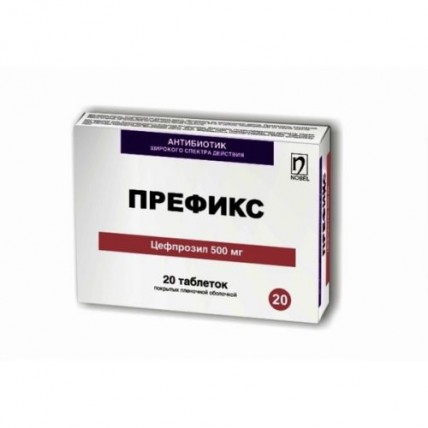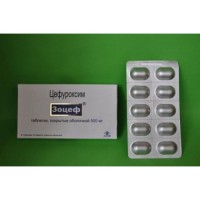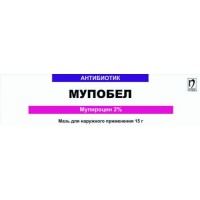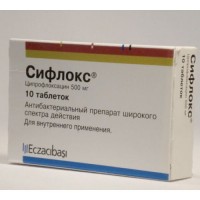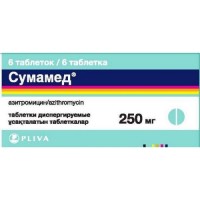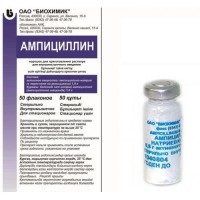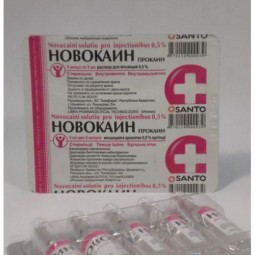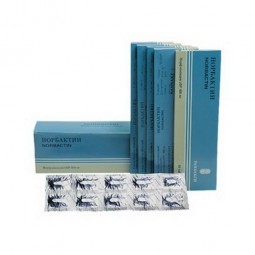Prefix 20s 500 mg film-coated tablets
- $35.20
The instruction for medical use
of PREFIX medicine
the Trade name
the PREFIX
the International unlicensed
name Tsefprozil Lekarstvennaya
a tablet form, film coated 500 mg
Structure
One tablet contains
active agent – a tsefprozil of monohydrate of 523.13 mg (it is equivalent to a tsefprozil of 500 mg)
excipients: cellulose microcrystalline PH 102, sodium starch glikolit (type A), magnesium stearate
structure of a cover: the titan dioxide, HPMC 3 cP – Methocel E3-LV, HPMC 6 cP – Methocel E6-LV, polyethyleneglycol 400, polysorbate 80, a simetikona an emulsion of 30%.
The description
of the Tablet, film coated white color, oblong shape, biconvex and with risky on one party.
Pharmacotherapeutic group
Beta laktamnye antibacterial drugs. Other.
Code of automatic telephone exchange J01DC10.
The pharmacological
Pharmacokinetics Later properties of intake about 95% of a tsefprozil are soaked up. Intake of the drug PREFIX along with food increases time of achievement of the maximum plasma concentration (Tmax) from 0.25 to 0.75 h, but does not influence extent of absorption (the area under a curve) or on the maximum plasma concentration (Cmax) tsefprozit. The bioavailability of a tsefprozil does not change after the accepted antacid in 5 minutes.
The volume of distribution is about 0.23 l/kg. About 36% of a tsefprozil contact proteins of plasma and does not depend on concentration ranging from 2 mkg/ml up to 20 mkg/ml. Data on accumulation of a tsefprozil in plasma at patients with normal function of kidneys after multiple dose in a dose to 1000 mg each 8 h within 10 days are absent. The established volume of distribution of a tsefprozil is 0.23 l/kg of body weight of the healthy adult patient with normal function of kidneys. At adult patients with normal function of kidneys the half-life period in plasma on average is 1 - 1.4 h.
The renal clearance of drug averages 1.78 - 2.53 ml/min. on body weight kg. Tsefprozil is brought generally with urine by glomerular filtration and canalicular secretion. About 54 - 70% of a single dose of drug are brought out of an organism in not changed view with urine during 24 h. At adult patients with normal function of the kidneys accepting a single dose of a tsefprozil of 250 mg, 500 mg or 1 g, concentration of drug in urine after the first 4 h averages 700, 1000 and 2900 mkg/ml, respectively.
At patients with renal failures the period of half-decay of a tsefprozil in plasma up to 5.2 h depending on degree of renal dysfunction is extended. At patients with total absence of renal function the half-life period of a tsefprozil in plasma reaches up to 5.9 h. The half-life period is shortened during a hemodialysis. The directions of discharge of drug at patients with an obvious renal failure are not defined.
At patients with abnormal liver functions the half-life period increases to 2 h. Amplitude of changes does not guarantee correction of a dose for patients of this group.
The pharmacodynamics
the PREFIX represents a semi-synthetic tsefalosporinovy antibiotic of the second generation. The PREFIX suppresses synthesis of a mukopeptid in a bacterial cell wall. Suppresses synthesis of a bacterial cell wall by binding one or more penicillin - the connecting proteins which in turn inhibit final transpeptidation of synthesis of a peptidoglikan in a bacterial cell wall and thus inhibits biosynthesis of a cell wall. As a result the bacterium is dissolved as a result of the proceeding activity of autolytic enzymes of a cell wall (autolysins and murein of hydrolase).
Tsefprozil is active in vitro concerning a wide range gram-positive and gram-negative bacteria. Bactericidal action of a tsefprozil – result of suppression of synthesis of a cell wall. The activity of a tsefprozil concerning the majority of strains of the following microorganisms as in vitro is proved, and in infections:
Aerobic gram-positive microorganisms:
Staphylococcus aureus * (including the strains produced β – lactamazu)
* Tsefprozil is inactive in the relation Methicillinum - steady stafilokokk.
Aerobic gram-negative microorganisms:
Haemophilus influenzae (including the strains produced β – lactamazu)
Tsefprozil is inactive Moraxella (Branhamella) catarrhalis (including the strains produced β – lactamazu) concerning Enterococcus faecium, Acinetobacter, Enterobacter, Morgnella morganii, Proteus vulgaris, Providencia, Pseudomonas and Serratia, Bacteroides fragillis.
Indications
- upper respiratory tract infections: pharyngitis, tonsillitis, average
otitis, acute sinusitis
- lower respiratory tract infections: bronchitis and pneumonia
- the skin infections (complicated and uncomplicated), the abscess
which is usually demanding a surgical drainage
- acute uncomplicated infections of urinary tract, including
acute cystitis
the Route of administration and doses
the PREFIX is shown for intake.
Adults and children are more senior than 13 years:
upper respiratory tract infections: in pharyngitis and tonsillitis each 24 h appoint 500 mg, in sinusitis the recommended dose makes 250 mg each 12 h, at moderate and severe forms - on 500 mg each 12 h,
lower respiratory tract infections: in bronchitis and pneumonia the recommended dose makes 500 mg each 12 h,
skin infections: in uncomplicated infections of skin and soft tissues the recommended rod makes 250 mg each 12 h or 500 mg everyone 24 h. If necessary each 12 h,
acute uncomplicated infections of urinary tract, including acute cystitis appoint 500 mg: the recommended dose makes 500 mg each 24 h.
Usually duration of treatment is 7 days. The course of treatment can be prolonged up to 10 days at patients with the infections caused by a beta and hemolytic streptococcus.
Side effects
Side reactions of a tsefprozil are similar to those of other cephalosporins. The PREFIX is usually well transferred. Only about 2% of patients were forced to stop therapy by drug, owing ment of side reactions:
- diarrhea, nausea
- colitis (including pseudomembranous colitis),
- increase in level of nuclear heating plant, ALT, increase in alkaline phosphatase also beat -
a ruby
- rash, urticaria
- dizziness
- a leukopenia, an eosinophilia
- increase in content in blood of urea nitrogen (BUN), serumal
creatinine
- a genital itching and a vaginitis
Seldom:
- vomiting and an abdominal pain
- cholestatic jaundice
- superactivity, a headache, nervousness, insomnia, the deputy -
a shatelstvo and drowsiness
- an anaphylaxis, a Quincke's edema
- a multiformny erythema
- fever, reactions like a serum disease
- Stephen-Johnson's syndrome
- thrombocytopenia.
Contraindications
- hypersensitivity to a tsefprozil and other cephalosporins.
- bleedings and diseases of digestive tract in the anamnesis,
including nonspecific ulcer colitis
- pregnancy and the period of a lactation
- children's age up to 13 years
Medicinal interactions
At a concomitant use of the PREFIX with
- aminoglikozidovy antibiotics was noted nephrotoxicity. – with probenetsidy, the area under a curve of a tsefprozil increases twice. Tsefalosporinovy antibiotics can cause false positive reaction to glucose in urine with Benedict or Felinga's reactant, and do not cause – with the test based on enzymes on a glucosuria. False-negative reaction can arise with ferricyanide at detection of glucose in blood. Existence of a tsefprozil in blood does not influence quantitative definition of creatinine in plasma and urine shchelochno - a pikratny method.
Special instructions
before therapy tsefprozily at patients it is necessary to conduct a careful research of presence of hypersensitivity to a tsefprozil, cephalosporins, penicillin or other medicines. It is necessary to show extra care when prescribing drug to patients with hypersensitivity to penicillinic antibiotics, owing ment of cross allergic reaction between β– laktamny antibiotics, meeting at more than 10% of the patients having in an anamnaza allergic reaction to penicillin. At emergence of allergic reaction, it is necessary to stop intake of drug. Serious hypersensitivity reactions to drug can demand therapy by epinephrine, etc. the emergency actions, including oxygenation, intravenous injection of liquid, intravenous administration of antihistaminic drugs, corticosteroids, pressor amines and ventilating therapy according to clinical indications.
Development of pseudomembranous colitis is noted practically at all antibacterial agents, including tsefprozit, and differs on weight of a course: from average to a life-threatening form. Therefore it is important to consider this diagnosis at patients at whom diarrhea after intake of antibacterial drugs is observed.
Treatment by antibacterial agents changes normal micro flora of a colon and can allow the overgrowth of clostridiums. Researches showed that the toxins produced by Clostridium defficile are one of basic reasons of development of the colitis connected with antibiotics.
After diagnosis of pseudomembranous colitis it is necessary to host the corresponding therapeutic actions. Pseudomembranous colitis of an average course usually passes only after drug withdrawal. At a moderate and heavy course of colitis it is necessary to use liquids and electrolytes, proteinaceous addition and therapy with the antibacterial agents effective concerning Clostridium defficile.
At patients with the known and expected renal failure the careful clinical inspection and the corresponding laboratory researches have to be carried out before and during treatment. The general daily dose of a tsefprozil at such patients has to be reduced owing to detection of high and/or long plasma concentration of an antibiotic when assigning a usual dose of drug. Cephalosporins, including tsefprozit, it is necessary to appoint with ostorozh-
a nost to the patients accepting at the same time strong diuretics after side effect on renal function of these means is expected.
Purpose of a tsefprozil in the absence of the revealed or obviously expected bacterial infections or for preventive indications can promote risk of development of bacteria, resistant to drug.
Tsefprozil has to be appointed with care to the certain patients having in the anamnesis gastrointestinal diseases, in particular, colitis.
During treatment by tsefalosporinovy antibiotics positive reaction of Koombs is possible.
Patients with a renal failure
From patients with a renal failure with clearance of creatinine 30 ml/min. are not required to modification of usual dosing of a tsef-prozil for patients also any more. Patients with clearance of creatinine have less than 30 ml/min., the frequency of reception has to be modified: such patients have to receive 50% of a usual dose of a tsefprozil with a usual interval of dosing. As drug is partially removed from an organism by a hemodialysis, at the patients receiving a hemodialysis tsefprozit has to be accepted after the end of the period of dialysis.
Patients with a liver failure
the patients with a liver failure have no need to adjust a drug dosage.
Patients of advanced age.
At patients 65 years accepting a single dose of a tsefprozil of 1 g are more senior increase in the area under curve from 35 to 65% and for 40% decrease in value of renal clearance in comparison with patients from 20 to 40 l is observed. Average height of the area under a curve at young and elderly women is 15 - 20% higher, than at men. Amplitude of such changes connected with age and a floor in pharmacokinetics of a tsefprozil is not so significant and does not demand correction of a dose.
Use in pediatrics.
There are no data on safety of use of the drug PREFIX for children up to 13 years.
Pregnancy and a lactation
Drug is contraindicated to use at pregnancy and in the period of a lactation. In need of purpose of the PREFIX the women need to estimate expected advantage for mother at the period of pregnancy and possible risk for a fruit. A small amount of a tsefprozil (less than 0.3% of a dose) is found in breast milk in the feeding women after reception of a single dose of drug of 1 g. Average daily concentration fluctuates from 0.25 to 3.3 mkg/ml.
The feature of influence of medicine on ability to run the vehicle or potentially dangerous mechanisms
needs to be careful during the driving of the car and occupations other potentially dangerous types of activity requiring special attention and speed of psychomotor reactions.
Overdose
Symptoms: loss of appetite, diarrhea, at heavy overdose: nausea, vomiting, intestinal colic, an apoplexy, decrease in sensitivity and feeling of pricking in hands and legs and also muscular spasms.
Treatment: In case of heavy overdose, especially at patients with renal failures, tsefprozit remove by means of a hemodialysis.
A form of release and packing
of the Tablet, film coated 500 mg, in the blister on 7 or 10 tablets, 1 or 2 blisters in a cardboard pack together with the instruction for use.
To Store storage conditions at a temperature not above 25 °C in the dry, protected from light place.
To store out of children's reach!
A period of storage
2 years
not to apply after a period of storage
Prescription status
According to the prescription
the Producer:
Nobel Ilach Sanai ve A.Sh. Tidzharet, Turkey
It is packed:
JSC Nobel Almatinskaya Pharmatsevticheskaya Fabrika
Republic of Kazakhstan
Almaty, Shevchenko St. 162 E.
of PREFIX medicine
the Trade name
the PREFIX
the International unlicensed
name Tsefprozil Lekarstvennaya
a tablet form, film coated 500 mg
Structure
One tablet contains
active agent – a tsefprozil of monohydrate of 523.13 mg (it is equivalent to a tsefprozil of 500 mg)
excipients: cellulose microcrystalline PH 102, sodium starch glikolit (type A), magnesium stearate
structure of a cover: the titan dioxide, HPMC 3 cP – Methocel E3-LV, HPMC 6 cP – Methocel E6-LV, polyethyleneglycol 400, polysorbate 80, a simetikona an emulsion of 30%.
The description
of the Tablet, film coated white color, oblong shape, biconvex and with risky on one party.
Pharmacotherapeutic group
Beta laktamnye antibacterial drugs. Other.
Code of automatic telephone exchange J01DC10.
The pharmacological
Pharmacokinetics Later properties of intake about 95% of a tsefprozil are soaked up. Intake of the drug PREFIX along with food increases time of achievement of the maximum plasma concentration (Tmax) from 0.25 to 0.75 h, but does not influence extent of absorption (the area under a curve) or on the maximum plasma concentration (Cmax) tsefprozit. The bioavailability of a tsefprozil does not change after the accepted antacid in 5 minutes.
The volume of distribution is about 0.23 l/kg. About 36% of a tsefprozil contact proteins of plasma and does not depend on concentration ranging from 2 mkg/ml up to 20 mkg/ml. Data on accumulation of a tsefprozil in plasma at patients with normal function of kidneys after multiple dose in a dose to 1000 mg each 8 h within 10 days are absent. The established volume of distribution of a tsefprozil is 0.23 l/kg of body weight of the healthy adult patient with normal function of kidneys. At adult patients with normal function of kidneys the half-life period in plasma on average is 1 - 1.4 h.
The renal clearance of drug averages 1.78 - 2.53 ml/min. on body weight kg. Tsefprozil is brought generally with urine by glomerular filtration and canalicular secretion. About 54 - 70% of a single dose of drug are brought out of an organism in not changed view with urine during 24 h. At adult patients with normal function of the kidneys accepting a single dose of a tsefprozil of 250 mg, 500 mg or 1 g, concentration of drug in urine after the first 4 h averages 700, 1000 and 2900 mkg/ml, respectively.
At patients with renal failures the period of half-decay of a tsefprozil in plasma up to 5.2 h depending on degree of renal dysfunction is extended. At patients with total absence of renal function the half-life period of a tsefprozil in plasma reaches up to 5.9 h. The half-life period is shortened during a hemodialysis. The directions of discharge of drug at patients with an obvious renal failure are not defined.
At patients with abnormal liver functions the half-life period increases to 2 h. Amplitude of changes does not guarantee correction of a dose for patients of this group.
The pharmacodynamics
the PREFIX represents a semi-synthetic tsefalosporinovy antibiotic of the second generation. The PREFIX suppresses synthesis of a mukopeptid in a bacterial cell wall. Suppresses synthesis of a bacterial cell wall by binding one or more penicillin - the connecting proteins which in turn inhibit final transpeptidation of synthesis of a peptidoglikan in a bacterial cell wall and thus inhibits biosynthesis of a cell wall. As a result the bacterium is dissolved as a result of the proceeding activity of autolytic enzymes of a cell wall (autolysins and murein of hydrolase).
Tsefprozil is active in vitro concerning a wide range gram-positive and gram-negative bacteria. Bactericidal action of a tsefprozil – result of suppression of synthesis of a cell wall. The activity of a tsefprozil concerning the majority of strains of the following microorganisms as in vitro is proved, and in infections:
Aerobic gram-positive microorganisms:
Staphylococcus aureus * (including the strains produced β – lactamazu)
* Tsefprozil is inactive in the relation Methicillinum - steady stafilokokk.
Aerobic gram-negative microorganisms:
Haemophilus influenzae (including the strains produced β – lactamazu)
Tsefprozil is inactive Moraxella (Branhamella) catarrhalis (including the strains produced β – lactamazu) concerning Enterococcus faecium, Acinetobacter, Enterobacter, Morgnella morganii, Proteus vulgaris, Providencia, Pseudomonas and Serratia, Bacteroides fragillis.
Indications
- upper respiratory tract infections: pharyngitis, tonsillitis, average
otitis, acute sinusitis
- lower respiratory tract infections: bronchitis and pneumonia
- the skin infections (complicated and uncomplicated), the abscess
which is usually demanding a surgical drainage
- acute uncomplicated infections of urinary tract, including
acute cystitis
the Route of administration and doses
the PREFIX is shown for intake.
Adults and children are more senior than 13 years:
upper respiratory tract infections: in pharyngitis and tonsillitis each 24 h appoint 500 mg, in sinusitis the recommended dose makes 250 mg each 12 h, at moderate and severe forms - on 500 mg each 12 h,
lower respiratory tract infections: in bronchitis and pneumonia the recommended dose makes 500 mg each 12 h,
skin infections: in uncomplicated infections of skin and soft tissues the recommended rod makes 250 mg each 12 h or 500 mg everyone 24 h. If necessary each 12 h,
acute uncomplicated infections of urinary tract, including acute cystitis appoint 500 mg: the recommended dose makes 500 mg each 24 h.
Usually duration of treatment is 7 days. The course of treatment can be prolonged up to 10 days at patients with the infections caused by a beta and hemolytic streptococcus.
Side effects
Side reactions of a tsefprozil are similar to those of other cephalosporins. The PREFIX is usually well transferred. Only about 2% of patients were forced to stop therapy by drug, owing ment of side reactions:
- diarrhea, nausea
- colitis (including pseudomembranous colitis),
- increase in level of nuclear heating plant, ALT, increase in alkaline phosphatase also beat -
a ruby
- rash, urticaria
- dizziness
- a leukopenia, an eosinophilia
- increase in content in blood of urea nitrogen (BUN), serumal
creatinine
- a genital itching and a vaginitis
Seldom:
- vomiting and an abdominal pain
- cholestatic jaundice
- superactivity, a headache, nervousness, insomnia, the deputy -
a shatelstvo and drowsiness
- an anaphylaxis, a Quincke's edema
- a multiformny erythema
- fever, reactions like a serum disease
- Stephen-Johnson's syndrome
- thrombocytopenia.
Contraindications
- hypersensitivity to a tsefprozil and other cephalosporins.
- bleedings and diseases of digestive tract in the anamnesis,
including nonspecific ulcer colitis
- pregnancy and the period of a lactation
- children's age up to 13 years
Medicinal interactions
At a concomitant use of the PREFIX with
- aminoglikozidovy antibiotics was noted nephrotoxicity. – with probenetsidy, the area under a curve of a tsefprozil increases twice. Tsefalosporinovy antibiotics can cause false positive reaction to glucose in urine with Benedict or Felinga's reactant, and do not cause – with the test based on enzymes on a glucosuria. False-negative reaction can arise with ferricyanide at detection of glucose in blood. Existence of a tsefprozil in blood does not influence quantitative definition of creatinine in plasma and urine shchelochno - a pikratny method.
Special instructions
before therapy tsefprozily at patients it is necessary to conduct a careful research of presence of hypersensitivity to a tsefprozil, cephalosporins, penicillin or other medicines. It is necessary to show extra care when prescribing drug to patients with hypersensitivity to penicillinic antibiotics, owing ment of cross allergic reaction between β– laktamny antibiotics, meeting at more than 10% of the patients having in an anamnaza allergic reaction to penicillin. At emergence of allergic reaction, it is necessary to stop intake of drug. Serious hypersensitivity reactions to drug can demand therapy by epinephrine, etc. the emergency actions, including oxygenation, intravenous injection of liquid, intravenous administration of antihistaminic drugs, corticosteroids, pressor amines and ventilating therapy according to clinical indications.
Development of pseudomembranous colitis is noted practically at all antibacterial agents, including tsefprozit, and differs on weight of a course: from average to a life-threatening form. Therefore it is important to consider this diagnosis at patients at whom diarrhea after intake of antibacterial drugs is observed.
Treatment by antibacterial agents changes normal micro flora of a colon and can allow the overgrowth of clostridiums. Researches showed that the toxins produced by Clostridium defficile are one of basic reasons of development of the colitis connected with antibiotics.
After diagnosis of pseudomembranous colitis it is necessary to host the corresponding therapeutic actions. Pseudomembranous colitis of an average course usually passes only after drug withdrawal. At a moderate and heavy course of colitis it is necessary to use liquids and electrolytes, proteinaceous addition and therapy with the antibacterial agents effective concerning Clostridium defficile.
At patients with the known and expected renal failure the careful clinical inspection and the corresponding laboratory researches have to be carried out before and during treatment. The general daily dose of a tsefprozil at such patients has to be reduced owing to detection of high and/or long plasma concentration of an antibiotic when assigning a usual dose of drug. Cephalosporins, including tsefprozit, it is necessary to appoint with ostorozh-
a nost to the patients accepting at the same time strong diuretics after side effect on renal function of these means is expected.
Purpose of a tsefprozil in the absence of the revealed or obviously expected bacterial infections or for preventive indications can promote risk of development of bacteria, resistant to drug.
Tsefprozil has to be appointed with care to the certain patients having in the anamnesis gastrointestinal diseases, in particular, colitis.
During treatment by tsefalosporinovy antibiotics positive reaction of Koombs is possible.
Patients with a renal failure
From patients with a renal failure with clearance of creatinine 30 ml/min. are not required to modification of usual dosing of a tsef-prozil for patients also any more. Patients with clearance of creatinine have less than 30 ml/min., the frequency of reception has to be modified: such patients have to receive 50% of a usual dose of a tsefprozil with a usual interval of dosing. As drug is partially removed from an organism by a hemodialysis, at the patients receiving a hemodialysis tsefprozit has to be accepted after the end of the period of dialysis.
Patients with a liver failure
the patients with a liver failure have no need to adjust a drug dosage.
Patients of advanced age.
At patients 65 years accepting a single dose of a tsefprozil of 1 g are more senior increase in the area under curve from 35 to 65% and for 40% decrease in value of renal clearance in comparison with patients from 20 to 40 l is observed. Average height of the area under a curve at young and elderly women is 15 - 20% higher, than at men. Amplitude of such changes connected with age and a floor in pharmacokinetics of a tsefprozil is not so significant and does not demand correction of a dose.
Use in pediatrics.
There are no data on safety of use of the drug PREFIX for children up to 13 years.
Pregnancy and a lactation
Drug is contraindicated to use at pregnancy and in the period of a lactation. In need of purpose of the PREFIX the women need to estimate expected advantage for mother at the period of pregnancy and possible risk for a fruit. A small amount of a tsefprozil (less than 0.3% of a dose) is found in breast milk in the feeding women after reception of a single dose of drug of 1 g. Average daily concentration fluctuates from 0.25 to 3.3 mkg/ml.
The feature of influence of medicine on ability to run the vehicle or potentially dangerous mechanisms
needs to be careful during the driving of the car and occupations other potentially dangerous types of activity requiring special attention and speed of psychomotor reactions.
Overdose
Symptoms: loss of appetite, diarrhea, at heavy overdose: nausea, vomiting, intestinal colic, an apoplexy, decrease in sensitivity and feeling of pricking in hands and legs and also muscular spasms.
Treatment: In case of heavy overdose, especially at patients with renal failures, tsefprozit remove by means of a hemodialysis.
A form of release and packing
of the Tablet, film coated 500 mg, in the blister on 7 or 10 tablets, 1 or 2 blisters in a cardboard pack together with the instruction for use.
To Store storage conditions at a temperature not above 25 °C in the dry, protected from light place.
To store out of children's reach!
A period of storage
2 years
not to apply after a period of storage
Prescription status
According to the prescription
the Producer:
Nobel Ilach Sanai ve A.Sh. Tidzharet, Turkey
It is packed:
JSC Nobel Almatinskaya Pharmatsevticheskaya Fabrika
Republic of Kazakhstan
Almaty, Shevchenko St. 162 E.
